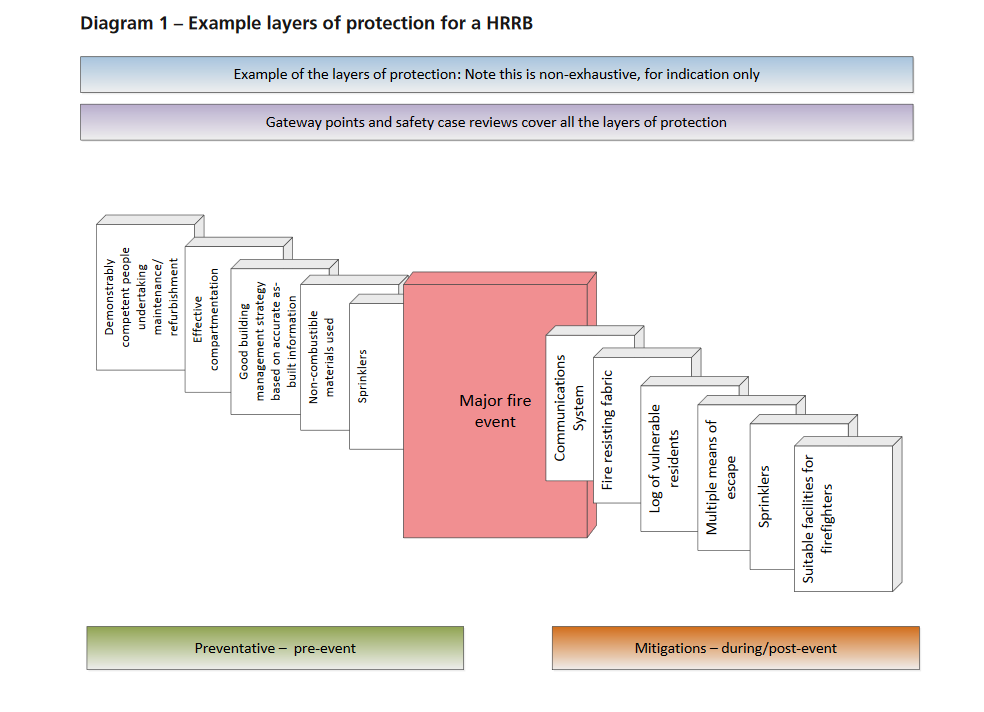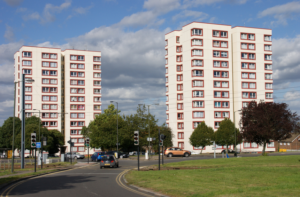
How far should the ‘ban’ of combustible materials in high rise construction go? …
About the ‘ban’ of combustible materials in high rise construction:
Jon Cumberlidge describes himself as a self professed 'Building Regs nerd' with almost two decades of experience within Construction and Regulatory Standards professions and, is both a Chartered Building Engineer and Chartered Builder plus he is also a corporate member of the Institution of Fire Engineers and a member of the Institution of Royal Engineers ... and, now provides a detailed commentary focused on the current Gov't announcing the shape of the future regulatory system following the Independent Review of Building Regulations and Fire Safety - Building a Safer Future or Hackitt Report as it has come to be known ...
Parliamentary statement – Grenfell Update 29th November 2018
... this is not a total ban on all combustible materials in all tall buildings that some perhaps were expecting but does however go a good way towards removing some the previous ambiguity and tightens the rules applying to certain types of building use. The details of which are given in the changes to the Regulations themselves and the Approved Documents which give technical guidance in support of the Regulations ...
The Building (Amendment) Regulations 2018
The new Regulations were laid before Parliament on the 29th November and come into effect on the 21st December 2018. They apply to England only.
... READ THE FULL ARTICLE BY JON CUMBERLIDGE HERE ...
-
A new definition of external wall
-
A new category under ‘material change of use’
-
An additional requirement under Regulation 7, ‘materials and workmanship’
2018 Amendments to Approved Document B, Volume 2
David Jones is now Director of Education and Training appointed at ICM - a Chartered Surveyor and a Fellow of the Chartered Institute of Building with nearly five decades of wide experience across the construction industry gained working in a number of parts of the World; with UK experience managing large multi-disciplined teams of construction professionals across three local authorities in London - procuring projects and networking through some of the most challenging recent times in public services - with a valuable insight into a range of corporate models and regimes – indeed, the range has been quite interesting – best value, CCT, TUPE, ALMOs, unitaries, client-side, in-house consultancy side, reorganisations, DLOs, etc. … what next can the empowered politicians do to affect [and lessen!] safety culture in procurement within public service he questions!
David was fortunate to be managing a multi-disciplinary construction team during the time when the UK government first enacted the EU Directive 92/57/EEC into UK law to create the Construction (Design and Management) Regulations - one of the very first tranche of 200 UK professionals to start CDM. Drawing upon experience David created and authored in 2007 the UK’s first online training to public services for the duty holders complying with CDM - won a number of awards including Constructing Excellence at both regional level and national finals! ... then in 2008 becoming one of three finalists in the UK for the title of ‘Health and Safety Champion of the Year’ for that innovative work creating online training to public services construction teams across the UK - provided accreditation to over 4,500 in-house local authority professionals - now leading innovation at ICM with the creation and launch of the National CDM Competence Registry™®
In context to the Grenfell Tower fire tragedy in 2017 and in direct contrast to the sad complexity of the evidence and commissioned report as it currently unfolds by the investigating QCs and their teams at the ongoing Phase 1 of the Inquiry, David Jones was commissioned by Croydon Council back in 1989 to design and manage over-cladding of the Council's stock of social HRRBs  by applying his extensive experience and cultural influence gained from working as a 'hands-on' curtain wall designer and façading engineer within a number of architectural practices. Those eight tower blocks in Croydon were among the dozen or so to pass the BRE's fire tests - and David is particularly proud to also have incorporated his then new patented gravity opening smoke vent and system into the steel panel and mineral insulated façade systems to keep the single protected escape staircase clear of noxious fumes ...
by applying his extensive experience and cultural influence gained from working as a 'hands-on' curtain wall designer and façading engineer within a number of architectural practices. Those eight tower blocks in Croydon were among the dozen or so to pass the BRE's fire tests - and David is particularly proud to also have incorporated his then new patented gravity opening smoke vent and system into the steel panel and mineral insulated façade systems to keep the single protected escape staircase clear of noxious fumes ...
New definition of External Wall :
An extensive definition of what constitutes an external wall is added under the heading Interpretation (2). The definition includes;
(i) anything located within any space forming part of the wall;
(ii) any decoration or other finish applied to any external (but not internal) surface forming part of the wall;
(iii) any windows and doors in the wall; and
(iv) any part of a roof pitched at an angle of more than 70 degrees to the horizontal if that part of the roof adjoins a space within the building to which persons have access, but not access only for the purpose of carrying out repairs or maintenance;
There is also a definition for specified attachments which include balconies, solar panels and brise soleil.
New category under ‘material change of use’ :
A new category is introduced within material change of use so that works to investigate and upgrade the external walls of a building will be required where, ‘the building is a building described in regulation 7(4)(a), where previously it was not”.
7(4)(a) is a reference to relevant buildings mentioned above. So, if you convert an office building that has a storey over 18 meters into student accommodation you would need to review the external wall construction and upgrade if it I did not meet the new requirements for combustibility. If you changed the use however to a hotel the requirement would not apply. Notwithstanding this current Regulations already make allowances for considering external fire spread via the walls by virtue of Regulation 6 (c) which requires B4(1) (external fire spread – walls) to be considered when a material change of use is carried out on a building exceeding 15 meters in height.
Additional requirement under Regulation 7, ‘materials and workmanship’ :
Regulation 7 (2) has been introduced which effectively states that, in relation to a relevant building, materials which become part of an external wall or specified attachment shall meet the classification for materials of limited combustibility A2 or non-combustible A1 in accordance with BS EN 13501, reference to all other classification methods (BS 476) have been removed. There are various exclusions from this requirement given in Regulation 7(3) examples being window frames, insulation and waterproofing material below ground and seals, gaskets etc.
David Jones reminds us that Albert Einstein is broadly credited with exclaiming “The definition of insanity is doing the same thing over and over again, but expecting different results” ... David contends it really doesn't make a difference that there's truly no proof that Einstein really put forth this expression; it's still an awesome quote! ~ and, it does express well his deep frustration of knowing CDM was flawed from the way the sector set it up all those 24 years ago! ~ David was one of the original 200 UK chartered professionals who first attended the HSE's roadshow when the newly installed Chief Inspector of Construction at the HSE Stuart Nattrass pleaded not to make CDM a 'profession' but consider it a 'competence' for all ~ yes, two small groups set up small companies as cash-cows and, the constructed fallacy that paying subs to a membership body or trade association somehow makes a professional competent! David has now launched the ICM CDM Competence Registry™® that hopes to find the CDM culture moving across the sector ... and, that new Registry will be inclusive of the statutory role needed for HRRB appointment to manage in compliance with the new Joint Competence Authority [JCA] to be set up by gov't ...
... so, David Jones throws you a question ~ "Hackitt has identified there is both a systemic failure of competence across the sector and there's not enough competent professionals so, until and unless ALL construction professionals have the proven skills, knowledge and expertise to prevent combustion, should there be a total ban of combustible materials in high rise construction?"
Ed.
